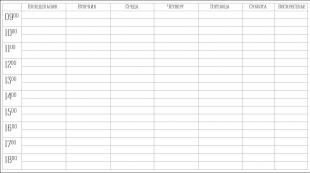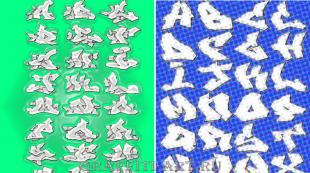The emf of the current source is determined by the expression. What is the electromotive force emf. Examples of problem solving
And what is its relationship with other parameters. Everyday life we all successfully use electrical appliances, many laws have been derived empirically and taken as an axiom. This is one of the reasons for the unnecessary complication of definitions. Unfortunately, even electromotive force, this basis of electrical engineering, is illuminated in such a way that it is rather difficult for a person unfamiliar with electricity to understand anything. Let's explain this issue using terms and examples that are clear to everyone.
In a conductor, it is called "electric current". As you know, all objects of our material world are composed of atoms. To simplify understanding, we can assume that each atom is represented in the form of a millions of times smaller nucleus in the center, and electrons rotate in circular orbits at different distances from it.
By means of any external influence in the conductor, which forms a closed loop, an electromotive force is created and the effect arises. The influence "knocks out" valence electrons from their orbits in atoms, therefore free electrons and positively charged ions are formed.
The electromotive force is necessary in order to "force" the charges to constantly move along the conductor and circuit elements in a certain direction. Without it, the current dies out almost instantly. To understand what the electromotive force is, the comparison of electricity with water will allow. A straight pipe section is a conductor. On its two sides, it goes out into the reservoirs. As long as the water levels in the reservoirs are equal and there is no slope, the liquid in the pipe is stationary.
Obviously, you can make it move in three ways: create a height difference (slope or amount of liquid in reservoirs) or forcibly pump it. An important point: if we talk about the height difference, then it means tension. For EMF, however, the movement is "forced", since the external forces exerting influence are non-potential.
Any source of electric current has an EMF - the very force that supports the movement of charged particles (in the given analogy, it makes water move). Measured in volts. The name speaks for itself: EMF characterizes the work of external forces applied to a section of the circuit that move each unit charge from one pole to another (between the terminals). It is numerically equal to the ratio of the work of the applied external forces to the value of the moved charge.
Indirectly, the need for an EMF source can be deduced from the law of conservation of energy and the properties of a conductor with a current. In a closed circuit, the work of the field to move charges is zero. However, the conductor heats up (and the more, the greater the current passes through it per unit of time). Conclusion: a share of external energy must be present in the circuit. The indicated external forces are the magnetic field in the generators, which constantly excites the electrons; the energy of chemical reactions in batteries.
The electromotive force of induction was first discovered experimentally in 1831. He found that an electric current arises in a conductor pierced by lines of intensity of a changing magnetic field. The action of the field gives the external electrons in the atoms the energy they lack, as a result of which they break off and begin to move (a current appears). Of course, there is no direct motion of particles (how can we not recall the relativity of the axioms of electrical engineering). Rather, there is an exchange of particles between nearby atoms.
The electromotive force developed is an intrinsic characteristic of any power source.
Electromagnetic induction - the generation of electric currents by magnetic fields that change over time. Faraday and Henry's discovery of this phenomenon introduced a certain symmetry into the world of electromagnetism. Maxwell, in one theory, managed to collect knowledge about electricity and magnetism. His research predicted the existence of electromagnetic waves before experimental observation. Hertz proved their existence and opened the era of telecommunications to mankind.
Faraday's and Lenz's laws
Electric currents create magnetic effects. Is it possible for a magnetic field to generate an electric one? Faraday discovered that the desired effects arise due to the change in the MF in time.
When a conductor is crossed by an alternating magnetic flux, an electromotive force is induced in it, causing an electric current. The system that generates the current can be a permanent magnet or an electromagnet.
The phenomenon of electromagnetic induction is regulated by two laws: Faraday and Lenz.
Lenz's law allows you to characterize the electromotive force in relation to its direction.
Important! The direction of the induced EMF is such that the current caused by it tends to oppose the cause that creates it.
Faraday noticed that the intensity of the induced current increases when the number of lines of force crossing the circuit changes faster. In other words, the EMF of electromagnetic induction is in direct proportion to the speed of the moving magnetic flux.

The EMF induction formula is defined as:
E = - dФ / dt.
The “-” sign shows how the polarity of the induced EMF is related to the flow sign and the varying velocity.
A general formulation of the law of electromagnetic induction is obtained, from which expressions for particular cases can be derived.
The movement of a wire in a magnetic field
When a wire of length l moves in a magnetic field with induction B, an EMF will be induced inside it, proportional to its linear speed v. To calculate the EMF, the formula is used:
- in the case of conductor movement perpendicular to the direction of the magnetic field:
E = - B x l x v;
- in the case of movement at a different angle α:
E = - B x l x v x sin α.
The induced EMF and current will be directed in the direction that we find using the rule right hand: by placing your hand perpendicular to the lines of force of the magnetic field and pointing your thumb towards the movement of the conductor, you can find out the direction of the EMF by the remaining four straightened fingers.

Spinning coil
The operation of the electricity generator is based on the rotation of the circuit in the MP, which has N turns.
EMF is induced in an electrical circuit whenever the magnetic flux crosses it, in accordance with the definition of the magnetic flux Ф = B x S x cos α (magnetic induction multiplied by the surface area through which the MF passes, and the cosine of the angle formed by vector B and a perpendicular line to plane S).
It follows from the formula that Ф is subject to changes in the following cases:
- the intensity of the MF changes - vector B;
- the area limited by the contour varies;
- the orientation between them, given by the angle, changes.
In the first experiments of Faraday, induced currents were obtained by changing the magnetic field B. However, you can induce an EMF without moving the magnet or changing the current, but simply rotating the coil around its axis in the MF. In this case, the magnetic flux changes due to a change in the angle α. During rotation, the coil crosses the lines of the MF, an EMF arises.
If the coil spins uniformly, this periodic change results in a periodic change in magnetic flux. Or the number of lines of force of the MP, crossed every second, takes equal values at equal intervals of time.

Important! The induced EMF changes with the orientation over time from positive to negative and vice versa. The graphical representation of the EMF is a sinusoidal line.
For the EMF formula of electromagnetic induction, the expression is used:
Е = В х ω х S x N x sin ωt, where:
- S - area limited by one turn or frame;
- N is the number of turns;
- ω is the angular velocity with which the coil rotates;
- B is the magnetic flux density of the MF;
- angle α = ωt.
In practice, in alternators, often the coil remains stationary (stator) while the electromagnet rotates around it (rotor).
EMF of self-induction
When passes through the coil alternating current, it generates an alternating MF with a varying magnetic flux that induces an EMF. This effect is called self-induction.
Since the MF is proportional to the current intensity, then:
where L is the inductance (H), determined by geometric values: the number of turns per unit length and the size of their cross-section.
For the induction EMF, the formula takes the form:
E = - L x dI / dt.
If two coils are located side by side, then an EMF of mutual induction is induced in them, depending on the geometry of both circuits and their orientation relative to each other. As the separation of the circuits increases, the mutual inductance decreases as the connecting magnetic flux decreases.

Let there be two coils. A current I1 flows through the wire of one coil with N1 turns, creating a MF passing through the coil with N2 turns. Then:
- Mutual inductance of the second coil relative to the first:
M21 = (N2 x F21) / I1;
- Magnetic flux:
Ф21 = (M21 / N2) x I1;
- Let's find the induced EMF:
E2 = - N2 x dФ21 / dt = - M21x dI1 / dt;
- EMF is induced identically in the first coil:
E1 = - M12 x dI2 / dt;
Important! The electromotive force caused by mutual induction in one coil is always proportional to the change in electric current in the other.
Mutual inductance can be considered equal:
M12 = M21 = M.
Accordingly, E1 = - M x dI2 / dt and E2 = M x dI1 / dt.
M = K √ (L1 x L2),
where K is the coupling coefficient between two inductances.
The phenomenon of mutual induction is used in transformers - electrical devices that allow you to change the value of the voltage of an alternating electric current. The apparatus consists of two coils wound around one core. The current present in the first creates a changing MF in the magnetic circuit and an electric current in the other coil. If the number of turns of the first winding is less than the other, the voltage increases, and vice versa.
In addition to generating, transforming electricity, magnetic induction is used in other devices. For example, in magnetic levitation trains, which do not move in direct contact with the rails, but several centimeters higher due to the electromagnetic repulsive force.
Video
What's happened EMF(electromotive force) in physics? Electric current is not clear to everyone. Like a cosmic distance, just under the very nose. In general, it is not fully understood by scientists either. Suffice it to recall with his famous experiments, centuries ahead of their time and even today remain in a halo of mystery. Today we do not solve big secrets, but we are trying to figure out what is emf in physics.
Determination of EMF in physics
EMF- electromotive force. Denoted by a letter E or the small Greek letter epsilon.
Electromotive force is a scalar physical quantity characterizing the work of external forces ( forces of non-electrical origin) operating in AC and DC electrical circuits.
EMF like tension e, is measured in volts. However, EMF and voltage are different phenomena.
Voltage(between points A and B) is a physical quantity equal to the work of the effective electric field performed when a single test charge is transferred from one point to another.
Explaining the essence of EMF "on the fingers"
To understand what is what, you can give an example-analogy. Let's imagine that we have water tower completely filled with water. Let's compare this tower to a battery.

Water exerts maximum pressure on the bottom of the tower when the tower is full. Accordingly, the less water in the tower, the weaker the pressure and pressure of the water flowing out of the tap. If you open the tap, the water will gradually flow out, first under strong pressure, and then more and more slowly, until the pressure is completely weakened. Here stress is the pressure that the water exerts on the bottom. We will take the bottom of the tower itself as the zero voltage level.

It's the same with the battery. First, we plug our current source (battery) into the circuit, short-circuiting it. Let it be a watch or a flashlight. As long as the voltage level is sufficient and the battery is not discharged, the flashlight shines brightly, then gradually goes out until it goes out completely.
But how to make sure that the pressure does not dry out? In other words, how to maintain a constant water level in the tower, and a constant potential difference at the poles of the current source. Following the example of the tower, the EMF is represented as a pump that provides the inflow of new water into the tower.

EMF nature
The cause of EMF in different current sources is different. By the nature of occurrence, the following types are distinguished:
- Chemical EMF. Occurs in batteries and accumulators due to chemical reactions.
- Thermo EMF. It occurs when the contacts of dissimilar conductors located at different temperatures are connected.
- EMF of induction. Occurs in a generator when a rotating conductor is placed in a magnetic field. EMF will be induced in a conductor when the conductor crosses the lines of force of a constant magnetic field or when the magnetic field changes in magnitude.
- Photoelectric EMF. The appearance of this EMF is facilitated by the phenomenon of an external or internal photoelectric effect.
- Piezoelectric EMF. EMF occurs when substances are stretched or squeezed.
Dear friends, today we have considered the topic "EMF for dummies". As you can see, EMF - non-electrical force, which maintains the flow of electric current in the circuit. If you want to know how problems with EMF are solved, we advise you to contact carefully selected and proven specialists who will quickly and intelligibly explain the course of solving any thematic problem. And according to tradition, at the end we invite you to watch a training video. Happy viewing and success in your studies!
Third-party (non-potential) forces in the sources of the post. or variable current; in a closed conducting circuit is equal to the work of these forces on the movement of a single posit. charge along the entire circuit. If we denote the intensity of the field of external forces through Есгр, then the emf? in a closed loop L is equal to
where dl is an element of the contour length.
Potenz. forces electrostatic. fields cannot support fasting. of these forces on a closed path is zero. The passage of current through the conductors is accompanied by the release of energy - the heating of the conductors. External forces are charged. ch-ts inside generators, galvanic cells, accumulators and other current sources. The origin of external forces can be different: in generators, these are forces from the side of a vortex electric. field arising from the change in magn. fields with time, or Lorentz, acting from the side of the magn. fields on el-ny in a moving conductor; in galvanic cells and batteries are chemical. force, etc. The emf of the source is equal to the electric voltage at its terminals when the circuit is open. Eds determines the current in the circuit at a given resistance (see OHMA LAW). Measured like electric. , in volts.
Physical encyclopedic dictionary. - M .: Soviet encyclopedia. . 1983 .
ELECTROMOTIVE FORCE
(emf) is a phenomenological characteristic of current sources. Introduced by G. Ohm (G. Ohm) in 1827 for DC circuits. current and defined by G. Kirchhoff in 1857 as the work of "outside" forces during the transfer of a single electric. charge along a closed loop. Then the concept of emf began to be interpreted more broadly - as a measure of specific (per unit of charge carried by the current) energy transformations carried out in quasi-stationary [see. Quasi-stationary (quasi-static) approximation] electric circuits not only by "third-party" sources (galvanic batteries, accumulators, generators, etc.), but also by "load" elements (electric motors, batteries in charging mode, chokes, transformers, etc.).
Full name values - E. s.- associated with mechanical. analogies of processes in electric. chains and rarely used; more common is the abbreviation - emf. In SI, the emf is measured in volts (V); in the Gaussian system (CGSE) unit emf spec. has no name (1 СГСЭ 300 V).
In the case of a quasilinear post. current in a closed (without branching) circuit of the total inflow of electromagnet. the energy generated by the sources is completely consumed for the generation of heat (see. Joule losses):
where is the emf in the conducting circuit, I-current, R - resistance (the sign of the emf, like the sign of the current, depends on the choice of the direction of bypassing along the contour).
When describing quasi-stationary processes in electric. chains in ur-niya energetic. balance (*) it is necessary to take into account changes in the accumulated magnetic W m and electrical W e energies:
When changing the magn. field in time there is a vortex electric. E
s, the circulation of which along the conductive circuit is usually called the emf electromagnetic induction:
Electrical changes energies are essential, as a rule, in cases where the circuit contains a large electric. capacity, for example. capacitors. Then dW e / dt = D U. I, where D U- potential difference between capacitor plates.
However, other interpretations of energetic are admissible. transformations into electric. chains. So, for example, if in the AC circuit. harmonious. current included with inductance L, then the mutual transformations of electric. and magn. energies in it can be characterized as emf el.-magn. induction and voltage drop across the effective reactance Z L(cm. Impedance): In moving in magn. field of bodies (for example, in the armature of a unipolar inductor), even the work of resistance forces can contribute to the emf.
In branched circuits of quasilinear currents, the ratio between the emf and voltage drops in the sections of the circuit that make up a closed loop is determined by the second Kirchhoff rule.
EDS is an integral characteristic of a closed loop, and in the general case it is impossible to strictly indicate the place of its "application". However, quite often the emf can be considered approximately localized in certain devices or circuit elements. In such cases, it is considered to be a characteristic of a device (galvanic battery, accumulator, dynamo, etc.) and is determined through the potential difference between its open poles. By the type of energy conversion in these devices, the following types of emf are distinguished: chemical emf in galvanic. batteries, baths, accumulators, during corrosive processes (galvanic effects), photoelectric emf (photo emf) at ext. and int. photoelectric effect (photocells, photodiodes); ELECTROMAGN and tn and emf - emf el.-magn. induction (dynamos, transformers, chokes, electric motors, etc.); electromotive force, arising, for example, when mechanical. friction (electric machines, electrification of thunderclouds, etc.); piezoelectric emf - when squeezing or stretching piezoelectrics (piezoelectric sensors, hydrophones, frequency stabilizers, etc.); thermionic emf associated with thermal emission charge. particles from the surface of heated electrodes; t e r mo e le c t r i h e s k and i emf ( thermoelectric power) - on the contacts of dissimilar conductors ( Seebeck effect and Peltier effect) or on sections of the chain with a non-uniform temperature distribution ( Thomson effect). Thermoelectric power is used in thermocouples, pyrometers, refrigerating machines.
M. A. Miller, G. V. Permitin.
Physical encyclopedia. In 5 volumes. - M .: Soviet encyclopedia. Chief Editor A.M. Prokhorov. 1988 .
See what "ELECTROMOTIVE FORCE" is in other dictionaries:
electromotive force- A scalar quantity characterizing the ability of an external field and an induced electric field to induce an electric current. Note - The electromotive force is equal to the linear integral of the strength of the external field and the induced ... ... Technical translator's guide The modern encyclopedia is a scalar quantity that characterizes the ability of an external field and an induced electric field to induce an electric current ...
In physics, such a concept as electromotive force(abbreviated - EMF) is used as the main energy characteristic of current sources.
Electromotive force (EMF)
Electromotive force (EMF) - the ability of the energy source to create and maintain a potential difference at the terminals.
EMF- measured in Volts
The voltage at the source terminals is always less EMF by the amount of voltage drop.

Electromotive force
U RH = E - U R0
U RH - voltage at the source terminals. Measured with a closed external circuit.
E - EMF - measured at the factory.
Electromotive force (EMF) is a physical quantity that is equal to the quotient of the division of the work that, when an electric charge moves, is performed by external forces in a closed circuit, to this charge itself.
It should be noted that electromotive force in the current source, it also arises in the absence of the current itself, that is, when the circuit is open. This situation is usually called "idle", and the value itself EMF when it is equal to the difference of those potentials that are available at the terminals of the current source.
Chemical electromotive force
Chemical electromotive force is present in accumulators, galvanic batteries during corrosive processes. Depending on the principle on which the operation of this or that power source is based, they are called either batteries or galvanic cells.
One of the main distinguishing characteristics of galvanic cells is that these power sources are, so to speak, disposable. During their functioning, those active substances due to which electrical energy is released, as a result of chemical reactions, disintegrate almost completely. That is why if the galvanic cell is completely discharged, then it is impossible to use it further as a current source.
Unlike galvanic cells, batteries are reusable. This is possible because the chemical reactions that take place in them are reversible.
Electromagnetic electromotive force
Electromagnetic EMF occurs during the operation of devices such as dynamos, electric motors, chokes, transformers, etc.
Its essence is as follows: when the conductors are placed in a magnetic field and they are moved in it in such a way that the intersection of the magnetic lines of force occurs, guidance occurs EMF... If the circuit is closed, then an electric current arises in it.
In physics, the phenomenon described above is called electromagnetic induction. Electromotive force, which is then induced, is called EMF induction.
It should be noted that aiming EMF induction occurs not only in those cases when the conductor moves in a magnetic field, but also when it remains stationary, but at the same time a change in the magnitude of the magnetic field itself is carried out.
Photoelectric electromotive force
This variety electromotive force occurs when there is either external or internal photoelectric effect.
In physics, the photoelectric effect (photoelectric effect) means that group of phenomena that occurs when a substance is exposed to light, and electrons are emitted in it. This is called the external photoelectric effect. If at the same time appears electromotive force or the electrical conductivity of a substance changes, then one speaks of an internal photoelectric effect.
Both external and internal photoeffects are now widely used for design and production. huge amount such light receivers, which convert light signals into electrical ones. All these devices are called photocells and are used both in technology and in carrying out various scientific research... In particular, it is the photocells that are used to make the most objective optical measurements.
Electrostatic driving force
As for this type electromotive force, then it, for example, arises during mechanical friction arising in electrophore units (special laboratory demonstration and auxiliary devices), it also takes place in thunderclouds.
Wimshurst generators (this is another name for electrophore machines) use such a phenomenon as electrostatic induction for their operation. During their operation, electric charges accumulate at the poles, in Leyden banks, and the potential difference can reach very solid values (up to several hundred thousand volts).
The nature of static electricity is that it occurs when, due to the loss or acquisition of electrons, intramolecular or intraatomic equilibrium is disturbed.
Piezoelectric electromotive force
This variety electromotive force occurs when there is either squeezing or stretching of substances called piezoelectrics. They are widely used in designs such as piezo sensors, crystal oscillators, hydrophones, and some others.
It is the piezoelectric effect that underlies the operation of piezoelectric sensors. They themselves belong to the so-called generator type sensors. In them, the input quantity is the applied force, and the output quantity is the amount of electricity.
As for devices such as hydrophones, their operation is based on the principle of the so-called direct piezoelectric effect, which piezoelectric materials have. Its essence is that if sound pressure is applied to the surface of these materials, then a potential difference arises on their electrodes. Moreover, it is proportional to the magnitude of the sound pressure.
One of the main areas of application for piezoelectric materials is the production of quartz oscillators with quartz resonators in their design. Such devices are intended in order to obtain oscillations of a strictly fixed frequency, which are stable both in time and with temperature changes, and also have a completely low level of phase noise.
Thermoionic electromotive force
This variety electromotive force occurs when thermal emission of charged particles occurs from the surface of heated electrodes. Thermoionic emission is widely used in practice, for example, the operation of almost all radio tubes is based on it.
Thermoelectric electromotive force
This variety EMF occurs when at different ends of dissimilar conductors, or simply at different parts of the circuit, the temperature is very unevenly distributed.
Thermoelectric electromotive force used in devices such as pyrometers, thermocouples, and refrigeration machines. Sensors whose operation is based on this phenomenon are called thermoelectric, and are, in fact, thermocouples, consisting of electrodes welded together, made of different metals. When these elements are either heated or cooled, a EMF, which is proportional in magnitude to the change in temperature.









